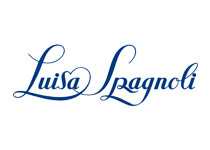Luisa Spagnoli
Apparel
Luisa Spagnoli is one of the best-known companies in Italy, a leader in the industry and sale of fashion clothing for women. Its headquarters are in Perugia, and it has a sales network of 140 shop...
Luisa Spagnoli is one of the best-known companies in Italy, a leader in the industry and sale of fashion clothing for women. Its headquarters are in Perugia, and it has a sales network of 140 shops located in the major cities and towns of Italy. Luisa Spagnoli was a very modern woman, endowed with talent, great creativity and intuition. She founded two of the most important companies in Perugia, mainstays of the process of industrialization in the province: Perugina and Luisa Spagnoli. She was fifty years ahead of the evolution of the working woman, not just as a businesswoman but also for having brought women into industry. In 1928 Luisa was the first to introduce the use of angora yarn for knitwear. She began raising a special breed of rabbit at her villa in Perugia, and at the same time built a workshop for the testing of spinning methods, yarns and knit fabrics, obtaining a thin, even yarn that she used to begin making elegant, high quality knitwear. She achieved great success in the fashion world of the time and developed a prosperous business, creating over one hundred jobs. Inheriting his mother’s imagination and creative brilliance, Mario Spagnoli developed the business, rebuilding and enlarging the factory that had been destroyed during the war In September 1944 he resumed production with 250 employees. In 10 years he built up the company’s reputation and prestige on national and international markets, shaping it as a true industry while maintaining the standards of tailor-made quality and design in the manufactured garments. Mario Spagnoli’s brilliance lies in having given the company its own network of shops selling exclusively Luisa Spagnoli productsBrand Details
Founder
Luisa Spagnoli
Designer
Nicoletta Spagnoli
from
1986to
currentMario Spagnoli
from
1986to
currentBrand Strategy
Market segment
Bridge
Core business
Apparel
Targets
Women
Luisa Spagnoli Latest News
Luisa Spagnoli Hires a New Executive VP
After working alongside the President, CEO, and Creative Director of Luisa Spagnoli, Nicola Barbarani has been appinted as the brand's Executive Vice President.
Luisa Spagnoli Holiday 2023
Luisa Spagnoli launches its Fall-Winter 2023 collection, comprising apparel and accessories, for the Holiday season.
Luisa Spagnoli Unveils New Boutique in Dubai
Luisa Spagnoli has inaugurated the opening of its new retail boutique in Dubai at the famous Dubai Mall.
Luisa Spagnoli Reconfirms Partnership with Digital Dust
Luisa Spagnoli has extended its partnership with Digital Dust for content production and social media strategic activities.
Luisa Spagnoli Financial Report 2024
Last fiscal year ended on December 31, 2015
